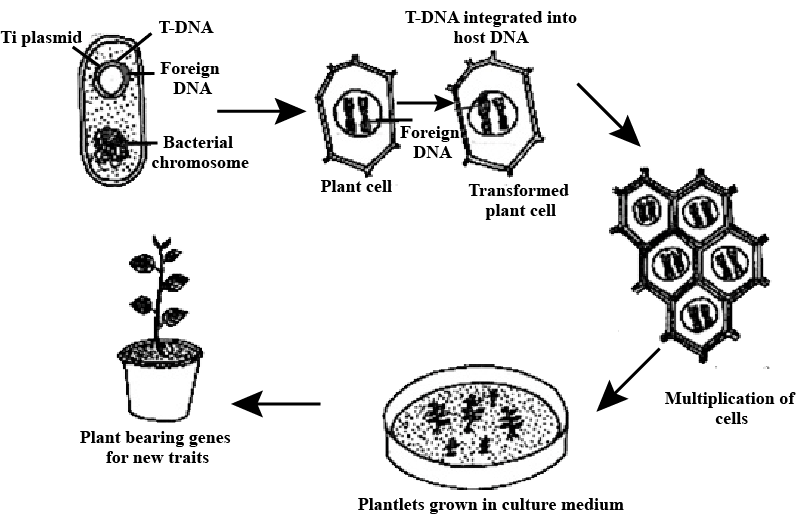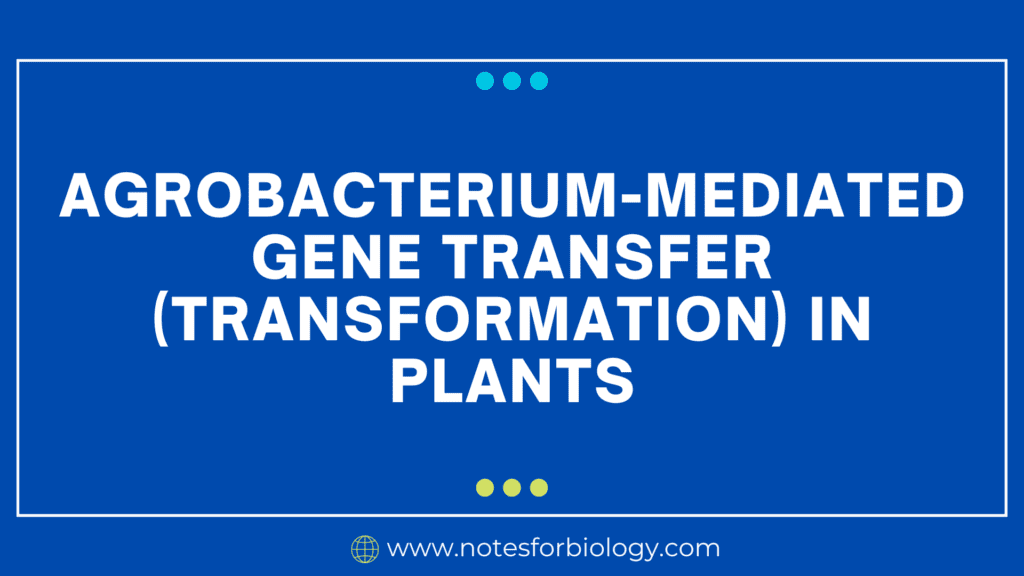Certainly! Agrobacterium-mediated gene transfer (AMGT) is a widely used method for stable plant transformation. Let’s delve into the details:
Table of Contents
Agrobacterium Basics
- Agrobacterium is a phytopathogen that infects plants through wound sites, causing crown gall disease. It is one of the most popular plant transformation tools in agriculture.
- The primary species involved is Agrobacterium tumefaciens, which utilizes its bacterial type IV secretion system to transfer its transferred (T)-DNA into host cells.
- Other species within the genus include A. radiobacter, A. vitis, A. rhizogenes, A. rubi, and A. tumefaciens.
- Agrobacterium strains can be isolated from various host plants worldwide, including roses, poplar, weeping fig, chrysanthemum, and fruit trees.

Mechanism of Agrobacterium-Mediated Transformation
The mechanism of Agrobacterium-Mediated Transformation is as follows:
- T-DNA, a fragment of plasmid, is transferred into plant cells by Agrobacterium during infection.
- After integrating into the nuclear genome, the T-DNA influences the host cell’s hormonal balance and permits the production of its own genes1.
- Agrobacterium is a perfect tool for plant transformation since it has several plasmids and can insert a DNA segment containing the tumor-inducing plasmid into the genome of the host cell.
Factors Affecting Agrobacterium-Mediated Gene Transfer
- a. Explants: The type of plant tissue used as the starting material affects transformation efficiency.
- b. Explants Wounding: Wounding the explants facilitates Agrobacterium infection.
- c. Plant Species and Genotype: Different plants respond differently to Agrobacterium.
- d. Antibiotics: Antibiotic selection helps identify transformed cells.
- e. Plant Growth Regulators (PGR): PGRs influence tissue regeneration.
- f. Light and Temperature: Optimal conditions enhance transformation.
- g. Agrobacterium Strains: Different strains exhibit varying transformation efficiencies.
Procedure for Agrobacterium-Mediated Gene Transfer
- Sterilization and Germination of Seeds
- Inoculum Preparation
- Preparation of Explants
- Shoot Initiation
- Regeneration
- Plant Acclimation
Applications and Limitations
- Applications: Agrobacterium-mediated gene transformation is used to generate transgenic plants.
- Limitations: Transformation efficiency can vary, and some plant species are less amenable to this method.
Remember that Agrobacterium-mediated gene transfer has significantly contributed to plant biotechnology, allowing researchers to introduce desirable traits into crops and improve agricultural practices.
How does Agrobacterium recognize plant cells?
Agrobacterium-mediated gene uses a convoluted procedure involving particular molecular interactions to recognize plant cells. Let’s examine the crucial actions:
Recognition and Attachment:
- An agrobacterium binds itself to damaged plant tissue, like a cut on a leaf or stem.
- The virulence proteins that it produces mediate the adhesion.
- Certain chemicals on the cell surface of plants, such as phenolic compounds produced following injury, are recognized by these proteins.
Virulence (Vir) Proteins:
- VirA and VirG are critical virulence proteins.
- VirA acts as a sensor kinase, detecting plant signals.
- VirG functions as a transcriptional activator.
Two-Component System:
- VirA autophosphorylates upon binding to plant signals.
- It transfers the phosphate group to VirG.
- Phosphorylated VirG activates transcription of virulence genes.
Virulence Genes (vir Genes):
- These genes encode proteins involved in T-DNA transfer.
- VirD1 and VirD2 proteins process the T-DNA.
- VirE2 coats the T-DNA, protecting it during transfer.
T-DNA Transfer:
- VirD2 binds to the T-DNA at its border sequences.
- The VirD2-T-DNA complex is transported into the plant cell nucleus.
- Integration of T-DNA into the plant genome occurs.
Plant Hormonal Response:
- The integrated T-DNA influences plant hormone levels.
- Auxins and cytokinins are affected, leading to uncontrolled cell division.
- This results in the characteristic crown gall tumor formation.
Overall Process:
- It recognizes wounded plant cells, attaches, and transfers T-DNA.
- The transformed plant cells express T-DNA genes, altering their growth and development.
Remember that this fascinating process has revolutionized plant biotechnology by allowing scientists to introduce desired genes into plants.
Frequently Asked Question(FAQ)
What is Agrobacterium in simple terms ?
is a phytopathogen that infects plants through wound sites, causing crown gall disease. It is one of the most popular plant transformation tools in agriculture.
How does Agrobacterium recognize plant cells?
Recognition and Attachment,Virulence (Vir) Proteins, Two-Component System,T-DNA Transfer, Plant Hormonal Response, Overall Process
What are it’s application?
Agrobacterium-mediated gene transformation is used to generate transgenic plants.
What are it’s procedure?
Sterilization and Germination of Seeds, Inoculum Preparation, Preparation of Explants, Shoot Initiation, Regeneration, Plant Acclimation.
Related Articles

